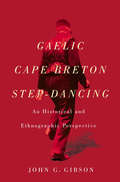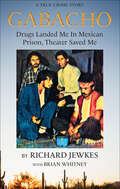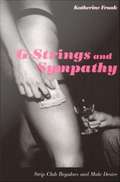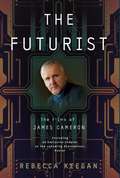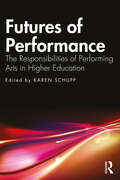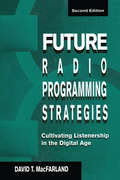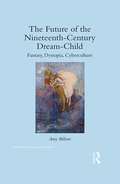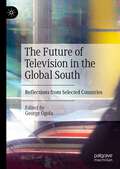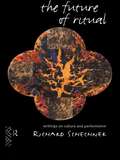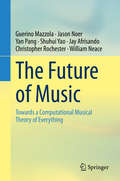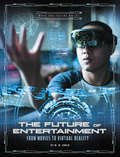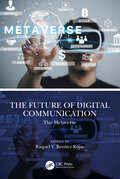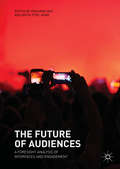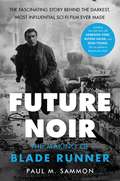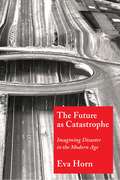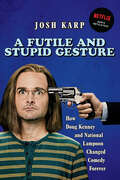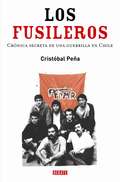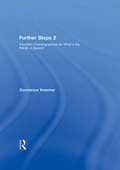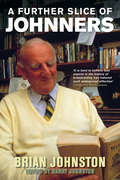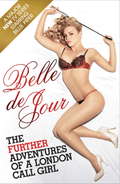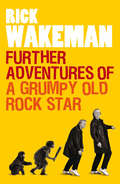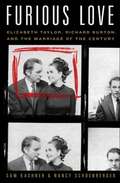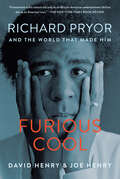- Table View
- List View
Gaia-Ästhetiken im zeitgenössischen Spielfilm: Das Wahrnehmbar-Werden der Erde in der filmischen Post/Apokalypse (Environmental Humanities #4)
by Friederike AhrensGaia-Ästhetiken entwerfen Figurationen der Erde und ihrer Lebensformen, welche die Menschen dezentrieren und den Fokus auf die Verbindungen zwischen Lebewesen untereinander und dem Unbelebten richten. Diese Ästhetiken sind der Gaia-Theorie entlehnt. In den 1970er Jahren bei der NASA entwickelt, wird sie von Bruno Latour und Isabelle Stengers in den Kontext des Anthropozäns gesetzt. Die Erde als Gaia ist eine mehr-als-menschliche Assemblage, in der die Menschen Knotenpunkte der Verantwortlichkeit darstellen. Filmische Ästhetiken können diese Knotenpunkte wahrnehmbar werden lassen, wie die Spielfilme I Am Legend (2007) und Planet of the Apes (2011-2017) zeigen. Die Filme präsentieren ihren Zuschauer_innen eine Welt in der Post/Apokalypse, in der die Filmfiguren mit dem Eindringen Gaias konfrontiert sind. Sie werden in der Post/Apokalypse kompostiert: Viren dringen in ihre Körper ein, zersetzen ihre Menschlichkeit und lassen sie zum Teil des mehr-als-menschlichen Gaia-Komposts werden.
Gaelic Cape Breton Step-Dancing: An Historical and Ethnographic Perspective (McGill-Queen's Studies in Ethnic History)
by John G. GibsonThe step-dancing of the Scotch Gaels in Nova Scotia is the last living example of a form of dance that waned following the great emigrations to Canada that ended in 1845. The Scotch Gael has been reported as loving dance, but step-dancing in Scotland had all but disappeared by 1945. One must look to Gaelic Nova Scotia, Cape Breton, and Antigonish County, to find this tradition. Gaelic Cape Breton Step-Dancing, the first study of its kind, gives this art form and the people and culture associated with it the prominence they have long deserved. Gaelic Scotland’s cultural record is by and large pre-literate, and references to dance have had to be sought in Gaelic songs, many of which were transcribed on paper by those who knew their culture might be lost with the decline of their language. The improved Scottish culture depended proudly on the teaching of dancing and the literate learning and transmission of music in accompaniment. Relying on fieldwork in Nova Scotia, and on mentions of dance in Gaelic song and verse in Scotland and Nova Scotia, John Gibson traces the historical roots of step-dancing, particularly the older forms of dancing originating in the Gaelic–speaking Scottish Highlands. He also places the current tradition as a development and part of the much larger British and European percussive dance tradition. With insight collected through written sources, tales, songs, manuscripts, book references, interviews, and conversations, Gaelic Cape Breton Step-Dancing brings an important aspect of Gaelic history to the forefront of cultural debate.
Gabacho: Drugs Landed Me In Mexican Prison, Theater Saved Me
by Brian Whitney Richard JewkesA young man&’s rebellion lands him in a Mexican prison, where theater becomes a lifeline in this memoir of angst, crime, friendship and redemption. Richard Jewkes was in his senior year as a University of Utah theater student when he became disenchanted with his strict Mormon upbringing. Over Christmas break, he and a college friend took off for Mexico seeking adventure. If the adventure hadn&’t included smuggling drugs, it might have just been another college road trip. But after a disastrous encounter with a drug cartel, the two young men ended up arrested by Mexican Federales while trying to make it to the US border. When Jewkes and his friend are tossed into a Mexican prison, they anticipate torture, assault, and even death. After a fight with a notorious killer and struggles with tormenting guards, they make a disastrous escape attempt. But ultimately, Jewkes finds his path to survival when he starts a theatre group with a rag-tag bunch of fellow convicts.
G-Strings and Sympathy: Strip Club Regulars and Male Desire
by Katherine FrankBased on her experiences as a stripper in a city she calls Laurelton--a southeastern city renowned for its strip clubs--anthropologist Katherine Frank provides a fascinating insider's account of the personal and cultural fantasies motivating male heterosexual strip club "regulars. " Given that all of the clubs where she worked prohibited physical contact between the exotic dancers and their customers, in G-Strings and Sympathy Frank asks what--if not sex or even touching--the repeat customers were purchasing from the clubs and from the dancers. She finds that the clubs provide an intermediate space--not work, not home--where men can enjoyably experience their bodies and selves through conversation, fantasy, and ritualized voyeurism. At the same time, she shows how the dynamics of male pleasure and privilege in strip clubs are intertwined with ideas about what it means to be a man in contemporary America. Frank's ethnography draws on her work as an exotic dancer in five clubs, as well as on her interviews with over thirty regular customers--middle-class men in their late-twenties to mid-fifties. Reflecting on the customers' dual desires for intimacy and visibility, she explores their paradoxical longings for "authentic" interactions with the dancers, the ways these aspirations are expressed within the highly controlled and regulated strip clubs, and how they relate to beliefs and fantasies about social class and gender. She considers how regular visits to strip clubs are not necessarily antithetical to marriage or long-term heterosexual relationships, but are based on particular beliefs about marriage and monogamy that make these clubs desirable venues. Looking at the relative "classiness" of the clubs where she worked--ranging from the city's most prestigious clubs to some of its dive bars--she reveals how the clubs are differentiated by reputations, dress codes, cover charges, locations, and clientele, and describes how these distinctions become meaningful and erotic for the customers. Interspersed throughout the book are three fictional interludes that provide an intimate look at Frank's experiences as a stripper--from the outfits to the gestures, conversations, management, coworkers, and, of course, the customers. Focusing on the experiences of the male clients, rather than those of the female sex workers, G-Strings and Sympathy provides a nuanced, lively, and tantalizing account of the stigmatized world of strip clubs.
The Futurist: The Life and Films of James Cameron
by Rebecca KeeganWith the release of Avatar in December 2009, James Cameron cements his reputation as king of sci-fi and blockbuster filmmaking. It's a distinction he's long been building, through a directing career that includes such cinematic landmarks as The Terminator, Aliens, The Abyss, and the highest grossing movie of all time, Titanic. The Futurist is the first in-depth look at every aspect of this audacious creative genius-culminating in an exclusive behind-the-scenes glimpse of the making of Avatar, the movie that promises to utterly transform the way motion pictures are created and perceived. As decisive a break with the past as the transition from silents to talkies, Avatar pushes 3-D, live action, and photo-realistic CGI to a new level. It rips through the emotional barrier of the screen to transport the audience to a fabulous new virtual world. With cooperation from the often reclusive Cameron, author Rebecca Keegan has crafted a singularly revealing portrait of the director's life and work. We meet the young truck driver who sees Star Wars and sets out to learn how to make even better movies himself-starting by taking apart the first 35mm camera he rented to see how it works. We observe the neophyte director deciding over lunch with Arnold Schwarzenegger that the ex-body builder turned actor is wrong in every way for the Terminator role as written, but perfect regardless. After the success of The Terminator, Cameron refines his special-effects wizardry with a big-time Hollywood budget in the creation of the relentlessly exciting Aliens. He builds an immense underwater set for The Abyss in the massive containment vessel of an abandoned nuclear power plant-where he pushes his scuba-breathing cast to and sometimes past their physical and emotional breaking points (including a white rat that Cameron saved from drowning by performing CPR). And on the set of Titanic, the director struggles to stay in charge when someone maliciously spikes craft services' mussel chowder with a massive dose of PCP, rendering most of the cast and crew temporarily psychotic. Now, after his movies have earned over $5 billion at the box office, James Cameron is astounding the world with the most expensive, innovative, and ambitious movie of his career. For decades the moviemaker has been ready to tell the Avatar story but was forced to hold off his ambitions until technology caught up with his vision. Going beyond the technical ingenuity and narrative power that Cameron has long demonstrated, Avatar shatters old cinematic paradigms and ushers in a new era of storytelling.
Futures of Performance: The Responsibilities of Performing Arts in Higher Education
by Schupp KarenFutures of Performance inspires both current and future artists/academics to reflect on their roles and responsibilities in igniting future-forward thinking and practices for the performing arts in higher education. The book presents a breadth of new perspectives from the disciplines of music, dance, theatre, and mediated performance and from a range of institutional contexts. Chapters from teachers across various contexts of higher education are organized according to the three main areas of responsibilities of performing arts education: to academia, to society, and to the field as a whole. With the intention of illuminating the intricacy of how performing arts are situated and function in higher education, the book addresses key questions including: How are the performing arts valued in higher education? How are programs addressing equity? What responsibilities do performing arts programs have to stakeholders inside and outside of the academy? What are programs’ ethical obligations to students and how are those met? Futures of Performance examines these questions and offers models that can give us some of the potential answers. This is a crucial and timely resource for anyone in a decision-making position within the university performing arts sector, from administrators, to educators, to those in leadership positions.
Future Radio Programming Strategies: Cultivating Listenership in the Digital Age (Routledge Communication Series)
by David MacFarlandFundamental beliefs is what the reader will be exploring here -- a common understanding of what the radio enterprise should be about: entertainment and information. A major thrust of this book is to arrive at a set of fundamental beliefs about the values and realities of the radio business in regard to entertainment programming -- a set of beliefs that may or may not be right, true, or forever, but that might at least provide a basis for developing programming strategies. This second edition of Future Radio Programming Strategies seeks to answer the question: "What do listeners really want from radio?" Some of the answers are derived from "users-and-gratifications" research in the mass media. Instead of focusing on what mass media do to people, the users-and-gratifications perspective seeks to discover what people do with mass media. The functionalist viewpoint of such research basically says that a medium is best defined by how people use it. Having looked at some of the audience research that comes from sources other than the standard ratings companies, the book then goes on to demonstrate new ways that formats, production procedures, and announcing styles can meet audience needs and desires. Although the volume concludes with several original methods for selecting and presenting airplay music based on the audience's moods and emotional needs, it does not insist upon a singular, formulaic approach for constructing or modifying a music format. Instead, it attempts to involve the reader in thinking through the process of format development. Two audio tapes are also available for use with the book. The tapes contain nearly 3 hours of important, detailed information and provocative points from the book. Exclusive audio examples include: * the sense of acoustic space in music; * hi-fi versus lo-fi listening environments; * subjective perception of the announcer's distance from the listener; * audio editing rates; * comparison of luxury versus inexpensive car listening experiences; and * the components of emotions that are expressed vocally. The tapes also include new sections about the threats to traditional radio from specialized digital audio services, competition for the listener's attention from computer-based media, and additional proof of how music can be chosen on the basis of listeners' emotional reactions and mood needs.
The Future of the Nineteenth-Century Dream-Child: Fantasy, Dystopia, Cyberculture (Children's Literature and Culture)
by Amy BilloneThis book investigates the reappearance of the 19th-century dream-child from the Golden Age of Children's Literature, both in the Harry Potter series and in other works that have reached unprecedented levels of popular success today. Discussing Harry Potter as a reincarnation of Lewis Carroll's Alice and J.M. Barrie's Peter Pan, Billone goes on to examine the recent resurrection of Alice in Tim Burton's Alice, and of Peter Pan in Michael Jackson and in James Bond. Visiting trends that have emerged since the Harry Potter series ended, the book studies revisions of the dream-child in texts and films that have inspired mass fandom in the twenty-first century: Stephenie Meyer's Twilight, E.L. James's 50 Shades of Grey and Suzanne Collins's The Hunger Games. The volume argues that the 21st-century desire to achieve dream-states in relationship to eternal youth results from the way that dreams provide a means of realizing the fantastic yet alarming possibility of escaping from time. This current identification with the dream-child stems from the threat of political unrest and economic and environmental collapse as well as from the simultaneous technophilia and technophobia of a culture immersed in the breathless revolution of the digital age. This book not only explores how the dream-child from the past has returned to reflect misgivings about imagined dystopian futures but also reveals how the rebirth of the dream-child opens up possibilities for new narratives where happy endings remain viable against all odds. It will appeal to scholars in a wide variety of fields including Childhood Studies, Children's/YA Literature, Cinema Studies, Cultural Studies, Cyberculture, Gender Studies, Queer Studies, Gothic Studies, New Media, and Popular Culture.
The Future of Television in the Global South: Reflections from Selected Countries
by George OgolaThis book explores how television in the global South is ‘future-proofing’ its continued relevance, addressing its commercial, social and political viability in a constantly changing information ecosystem. The chapter contributions in the book are drawn from countries in East, South and West Africa, the Middle East and Latin America, specially selected for their illustrative potential of the key issues addressed in the book. Scholarly attention on television in the global South has largely been limited to studying evolving television formats with broader structural issues covered almost entirely by industry reports. Major gaps remain in terms of understanding how television in the global South is changing within the context of the significant technological developments and what this means for television’s future(s). The chapters reflect on these futures, not in the sense of predicting what these might be, but rather anticipating important areas of intellection. The contributors contend that much of the scholarship on the global South, by scholars from the South, is often stilted by a reluctance to anticipate. This failure leads to a largely reactionary scholarship, constantly oppositional, and unable to recentre conversations on the South. This volume finds intellectual incentive in this urgent need to anticipate, hence its particular focus on television futures. Taking television in the global South as an important cultural and political barometer, the book seeks to explore how television in the global South is adapting to the rampant technological changes and processes of globalisation.
The Future of Ritual: Writings on Culture and Performance
by Richard SchechnerIn The Future of Ritual, Richard Schechner explores the nature of ritualised behaviour and its relationship to performance and politics. A brilliant and uncontainable examination of cultural expression and communal action, The Future of Ritual asks pertinent questions about art, theatre and the changing meaning of 'culture' in today's intercultural world. An exciting new work by the author of Performance Theory.
The Future of Music: Towards a Computational Musical Theory of Everything
by Guerino Mazzola Yan Pang Jason Noer Shuhui Yao Jay Afrisando Christopher Rochester William NeaceThe idea of this monograph is to present an overview of decisive theoretical, computational, technological, aesthetical, artistic, economical, and sociological directions to create future music. It features a unique insight into dominant scientific and artistic new directions, which are guaranteed by the authors' prominent publications in books, software, musical, and dance productions.Applying recent research results from mathematical and computational music theory and software as well as new ideas of embodiment approaches and non-Western music cultures, this book presents new composition methods and technologies. Mathematical, computational, and semiotic models of artistic presence (imaginary time, gestural creativity) as well as strategies are also covered.This book will be of interest to composers, music technicians, and organizers in the internet-based music industry, who are offered concrete conceptual architectures and tools for their future strategies in musical creativity and production.
The Future of Entertainment: From Movies to Virtual Reality (What the Future Holds)
by M. M. EbochFrom stage productions to television to movies, humans have always been entertained by a good story. But how might entertainment change in the future? From immersive virtual reality games to social media with 3-D holograms, readers can find out what cool new technologies might change the way they are entertained.
The Future of Digital Communication: The Metaverse
by Raquel V. Benítez RojasThis collection of essays explores the present and future of digital communication through a range of interdisciplinary approaches, all of which focus on the so-called metaverse. The metaverse is a combination of multiple elements of technology – including virtual reality, augmented reality, and video – where users "live" within a digital universe. The vision for this new universe is that its users can work, play, and stay connected with friends through everything. Such a vision is hinted at in existing phenomena such as online game universes.
The Future of Audiences: A Foresight Analysis Of Interfaces And Engagement
by Ranjana Das Brita Ytre-ArneThis book brings together contributions from scholars across Europe to present findings from a foresight analysis exercise on audiences and audience analysis, looking towards an increasingly datafied world and anticipating the ubiquity of the internet of things. The book uses knowledge emerging out of three foresight exercises, produced in co-operation with more than 50 stake-holding organisations and building on systematic reviews of audience research. It works through these exercises to arrive at a renewed agenda for audience studies within communication scholarship in the context of intrusive and connected interfaces and emerging communicative practices.
Future Noir: The Making of Blade Runner
by Paul M. SammonThe ultimate guide to Ridley Scott’s transformative sci-fi classic Blade RunnerRidley Scott’s 2007 “Final Cut” confirmed the international film cognoscenti’s judgment: Blade Runner, based on Philip K. Dick’s brilliant and troubling science fiction masterpiece Do Androids Dream of Electric Sheep?, is among the most visually dense, thematically challenging, and influential science fiction films ever made. Future Noir Revised & Updated Edition offers a deeper understanding of this cinematic phenomenon that is storytelling and visual filmmaking at its best.In this intensive, intimate, and anything-but-glamorous behind-the-scenes account, film insider and cinephile Paul M. Sammon explores how Ridley Scott purposefully used his creative genius to transform the work of science fiction’s most uncompromising author into a critical sensation and cult classic that would reinvent the genre. Sammon reveals how the making of the original Blade Runner was a seven-year odyssey that would test the stamina and the imagination of writers, producers, special effects wizards, and the most innovative art directors and set designers in the industry at the time it was made. This revised and expanded edition of Future Noir includes:An overview of Blade Runner’s impact on moviemaking and its acknowledged significance in popular culture since the book’s original 1996 publicationAn exploration of the history of Blade Runner: The Final Cut and its theatrical release in 2007A look at its long-awaited sequel, Blade Runner 2049The longest interview Harrison Ford has ever granted about Blade RunnerExclusive new interviews with Rutger Hauer and Sean YoungA fascinating look at the ever-shifting interface between commerce and art, illustrated with production photos and stills, Future Noir provides an eye-opening and enduring look at modern moviemaking, the business of Hollywood, and one of the greatest films of all time.
The Future as Catastrophe: Imagining Disaster in the Modern Age
by Eva HornWhy do we have the constant feeling that disaster is looming? Beyond the images of atomic apocalypse that have haunted us for decades, we are dazzled now by an array of possible catastrophe scenarios: climate change, financial crises, environmental disasters, technological meltdowns—perennial subjects of literature, film, popular culture, and political debate. Is this preoccupation with catastrophe questionable alarmism or complacent passivity? Or are there certain truths that can be revealed only in apocalypse?In The Future as Catastrophe, Eva Horn offers a novel critique of the modern fascination with disaster, which she treats as a symptom of our relationship to the future. Analyzing the catastrophic imaginary from its cultural and historical roots in Romanticism and the figure of the Last Man, through the narratives of climatic cataclysm and the Cold War’s apocalyptic sublime, to the contemporary popularity of disaster fiction and end-of-the-world blockbusters, Horn argues that apocalypse always haunts the modern idea of a future that can be anticipated and planned. Considering works by Lord Byron, J. G. Ballard, and Cormac McCarthy and films such as 12 Monkeys and Minority Report alongside scientific scenarios and political metaphors, she analyzes catastrophic thought experiments and the question of survival, the choices legitimized by imagined states of exception, and the contradictions inherent in preventative measures taken in the name of technical safety or political security. What makes today’s obsession different from previous epochs’ is the sense of a “catastrophe without event,” a stealthily creeping process of disintegration. Ultimately, Horn argues, imagined catastrophes offer us intellectual tools that can render a future shadowed with apocalyptic possibilities affectively, epistemologically, and politically accessible.
A Futile nd Stupid Gesture: How Doug Kenney and National Lampoon Changed Comedy Forever
by Josh KarpThe ultimate biography of National Lampoon and its cofounder Doug Kenney, this book offers the first complete history of the immensely popular magazine and its brilliant and eccentric characters. With wonderful stories of the comedy scene in New York City in the 1970s and National Lampoon's place at the center of it, this chronicle shares how the magazine spawned a popular radio show and two long-running theatrical productions that helped launch the careers of John Belushi, Bill Murray, Chevy Chase, and Gilda Radner and went on to inspire Saturday Night Live. More than 130 interviews were conducted with people connected to Kenney and the magazine, including Chevy Chase, John Hughes, P. J. O'Rourke, Tony Hendra, Sean Kelly, Chris Miller, and Bruce McCall. These interviews and behind-the-scenes stories about the making of both Animal House and Caddyshack help to capture the nostalgia, humor, and popular culture that National Lampoon inspires.
Los fusileros
by Cristóbal PeñaLa tarde del domingo 7 de septiembre de 1986, en el Cajón del Maipo, un comando del Frente Patriótico Manuel Rodríguez (FPMR) tendió una emboscada a la caravana que trasladaba al general Augusto Pinochet. La temeraria acción pasó a la historia y sus protagonistas - entre los que se contaban un escolar, un gásfiter, un bombero, un fisicoculturista, un cantautor, un ex seminarista de Schoenstatt y un estudiante de Cine y otro de Filosofía- cayeron en el olvido y corrieron suertes dispares. Narrada en clave de thriller político y policial, esta crónica acude al presente para reconstruir la historia de los veintiún fusileros que esa tarde de domingo desafiaron al régimen, convencidos de que no saldrían con vida.
Further Steps 2: Fourteen Choreographers on What's the R.A.G.E. in Modern Dance
by Constance KreemerFurther Steps 2 brings together New York’s foremost choreographers – among them MacArthur ‘Genius’ award winners Meredith Monk and Bill T. Jones – to discuss the past, present and future of dance in the US. In a series of exclusive and enlightening interviews, this diverse selection of artists discuss the changing roles of race, gender, politics, and the social environment on their work. Bringing her own experience of the New York dance scene to her study, Constance Kreemer traces the lives and works of the following choreographers: Lucinda Childs, Douglas Dunn, Molissa Fenley, Rennie Harris, Bill T. Jones, Kenneth King, Nancy Meehan, Meredith Monk, Rosalind Newman, Gus Solomons jr, Doug Varone, Dan Wagoner, Mel Wong and Jawole Zollar.
A Further Slice Of Johnners
by Brian JohnstonWhen Brian Johnston was a schoolboy, his reports were full of phrases such as 'talks too much in school' and 'apt to be a buffoon'. Later millions of radio listeners would be delighted to discover that some things never changed! Johnners brought his unique wit and personal charm to an enormous range of BBC radio and television programmes for nearly 50 years, from In Town Tonight and Down Your Way to Test Match Special. After Brian died in 1994, Christopher Martin-Jenkins wrote: 'It is hard to believe that anyone in the history of broadcasting has induced such widespread affection'. A Further Slice of Johnners covers Brian's early days, from his childhood in Hertfordshire and his schooldays at Eton and Oxford to his job in the family coffee business in the City and his service with the Grenadier Guards during the Second World War. There is also a selection of the most memorable characters and locations from his fifteen years on the Radio Four programme Down Your Way. Finally there is a collection of Brian's popular 'View From the Boundary' interviews on Test Match Special, including fascinating conversations with Eric Idle, John Major and Peter O'Toole.
The Further Adventures of a London Call Girl
by Belle de Jour''She lists like Hornby. She talks dirty like Amis. She has the misanthropy of Larkin and examines the finer points of sexual technique as she is adjusting the torque on a beloved but temperamental old E-type...It's hard to believe that this clever and candid new voice has no more to say. Whoever the author is, she should give up the day job. Only then will we find out what the real Belle de Jour is made of.' IndependentThis follow-up to the hugely successful 'Intimate Adventures' will be just as bold, funny and brilliant. Peppered with agony-aunt letters and advice, and stories from her 'working' life, it's also the story of a young woman making her way in the world - told in Belle's inimitable voice.
The Further Adventures of a London Call Girl
by Belle de Jour''She lists like Hornby. She talks dirty like Amis. She has the misanthropy of Larkin and examines the finer points of sexual technique as she is adjusting the torque on a beloved but temperamental old E-type...It's hard to believe that this clever and candid new voice has no more to say. Whoever the author is, she should give up the day job. Only then will we find out what the real Belle de Jour is made of.' IndependentThis follow-up to the hugely successful 'Intimate Adventures' will be just as bold, funny and brilliant. Peppered with agony-aunt letters and advice, and stories from her 'working' life, it's also the story of a young woman making her way in the world - told in Belle's inimitable voice.
Further Adventures of a Grumpy Old Rock Star
by Rick WakemanWhat do Postman Pat, Tommy Cooper, Norman Wisdom and George Best have in common with being abandoned in a Costa Rican jungle after a severe bout of flatulence? Indeed, how are they also connected to trying to buy an Australian brewery just to get a beer, owning twenty-two cars, an American soccer team and a Swiss mail-order pornography company?The common feature is of course a certain Richard Wakeman.The Further Adventures of a Grumpy Old Rock Star takes you, the privileged reader, on a trip of absurd excess, a cultural car crash of side-splitting hilarity and an unforgettable glimpse (again) into the life of one of Britain's most legendary showmen, rock stars and all-time great raconteurs.
Furious Love: Elizabeth Taylor, Richard Burton, and the Marriage of the Century
by Nancy Schoenberger Sam KashnerThe definitive story of Hollywood's most famous couple. He was a tough-guy Welshman softened by the affections of a breathtakingly beautiful woman; she was a modern-day Cleopatra madly in love with her own Mark Antony. For nearly a quarter of a century, Elizabeth Taylor and Richard Burton were Hollywood royalty, and their fiery romance--often called "the marriage of the century"--was the most notorious, publicized, and celebrated love affair of its day. For the first time, Vanity Fair contributing editor Sam Kashner and acclaimed biographer Nancy Schoenberger tell the complete story of this larger-than-life couple, showing how their romance and two marriages commanded the attention of the world. Also for the first time, in exclusive access given to the authors, Elizabeth Taylor herself gives never-revealed details and firsthand accounts of her life with Burton. Drawing upon brand-new information and interviews--and on Burton's private, passionate, and heartbreaking letters to Taylor--Furious Love sheds new light on the movies, the sex, the scandal, the fame, the brawls, the booze, the bitter separations, and, of course, the fabled jewels. It offers an intimate glimpse into Elizabeth and Richard's privileged world and their elite circle of friends, among them Princess Grace, Montgomery Clift, the Duke and Duchess of Windsor, Peter O'Toole, Michael Caine, Marlon Brando, Rex Harrison, Mike Nichols, Laurence Olivier, Robert Kennedy, Tennessee Williams, NoËl Coward, John Huston, Ava Gardner, the Rothschilds, Maria Callas, and Aristotle Onassis. It provides an entertaining, eye-opening look at their films, their wildly lucrative reign in Europe and in Hollywood-and the price they paid for their extravagant lives. Shocking and unsparing in its honesty, Furious Love explores the very public marriage of "Liz and Dick" as well as the private struggles of Elizabeth and Richard, including Le Scandale, their affair on the set of the notorious epic Cleopatra that earned them condemnation from the Vatican; Burton's hardscrabble youth in Wales; the crippling alcoholism that nearly destroyed his career and contributed to his early death; the medical issues that plagued both him and Elizabeth; and the failed aspirations and shame that haunted him throughout their relationship. As Kashner and Schoenberger illuminate the events and choices that shaped this illustrious couple's story, they demonstrate how the legendary pair presaged America's changing attitudes toward sex, marriage, morality, and celebrity. Yet ultimately, as the authors show, Elizabeth and Richard shared something priceless beyond the drama: enduring love. Addictive and entertaining, Furious Love is more than a celebrity biography; it's an honest yet sympathetic portrait of a man, a woman, and a passion that shocked and mesmerized the world.
Furious Cool: Richard Pryor and the World That Made Him
by David Henry Joe Henry“Addictively readable . . . Someday, when fewer people know Richard Pryor’s name, Furious Cool will be the best defense against the worst sort of forgetting--the kind that involves who we are now, who we loved once, and why.” —EsquireRichard Pryor was arguably the single most influential performer of the second half of the twentieth century, and certainly he was the most successful black actor/comedian ever. Controversial and somewhat enigmatic during his life, Pryor’s performances opened up a whole new world of possibilities, merging fantasy with angry reality in a way that wasn’t just new--it was theretofore unthinkable. Now, this groundbreaking and revelatory work brings him to life again both as a man and as an artist, providing an in-depth appreciation of his talent and his lasting influence, as well as an insightful examination of the world he lived in and the myriad influences that shaped both his persona and his art. “A testament to [Pryor’s] stature not only as an African-American entertainment idol but also as an American icon . . . The Henrys’ exuberant tribute may well evoke renewed interest in a performance genius who remade the face of American stand-up comedy.” —The New York Times Book Review“A sleek, highly literate biography that places the comic in the pop-cultural context of his times.” —Bloomberg News“Richard Pryor was the most free black man of the twentieth century. He also was a comic genius. This book gives the definitive reasons why he was so free and so sublime.” —Dr. Cornel West“David Henry and Joe Henry have brought Richard Pryor back to pulsating life, affirming both his humanity and his immortality as a comic--and tragic--genius . . . Furious Cool is a fabulous history, alive with fascinating characters.” —The Huffington Post

